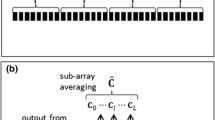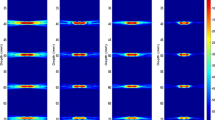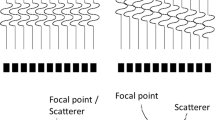Abstract
Purpose
High-frame-rate ultrasound is the predominant technique for the measurement of tissue dynamics. It enables an imaging frame rate of over 1 kHz using unfocused transmit beams and parallel receive beamforming. On the other hand, the spatial resolution is degraded compared to the conventional method based on sequential transmissions of focused beams. For improvement of the spatial resolution of high-frame-rate ultrasound, we have investigated a kind of adaptive beamformer, i.e., amplitude and phase estimation (APES) beamformer.
Method
In our previous study, it was shown that the APES beamformer realized a significantly better spatial resolution than the conventional delay and sum (DAS) beamformer without sub-array averaging and diagonal loading by considering the directivity of each transducer element. By omitting sub-array averaging and adding sub-aperture beamforming, the computational load could also be reduced significantly. One shortcoming of the proposed APES beamformer with element directivity, i.e., modified APES beamformer, is the degradation of penetration compared with the conventional APES beamformer with sub-array averaging and diagonal loading. In the present study, sub-array averaging and diagonal loading were applied to the modified APES beamformer for the improvement of the penetration.
Results
The conventional and modified APES beamformers realized similar performances when used with sub-array averaging and diagonal loading. Furthermore, the modified APES beamformer realized better spatial resolution and improved penetration when used with sub-aperture beamforming and diagonal loading. The modified APES beamformer with diagonal loading at 0.025 of the received power realized a penetration similar to that of the conventional APES beamformer with sub-array averaging and diagonal loading. The lateral spatial resolutions achieved with the conventional and modified APES beamformers were 0.36 and 0.31 mm, respectively. In addition, the modified APES beamformer could reduce the dimension of the covariance matrix to \(4\times 4\), versus \(48\times 48\) of the conventional APES beamformer, resulting in a computation time of only 1.1 %.
Conclusion
Penetration of the modified APES beamformer could be improved significantly by diagonal loading, which hardly increases the computational complexity.






Similar content being viewed by others
References
Shattuck DP, Weinshenker MD, Smith SW, von Ramm OT. Explososcan: a parallel processing technique for high speed ultrasound imaging with linear phased arrays. J Acoust Soc Am. 1984;75:1273–82.
Tanter M, Bercoff J, Sandrin L, Fink M. Ultrafast compound imaging for 2-D motion vector estimation: application to transient elastography. IEEE Trans Ultrason Ferroelectr Freq Control. 2002;49:1363–74.
Hasegawa H, Kanai H. Simultaneous imaging of artery-wall strain and blood flow by high frame rate acquisition of RF signals. IEEE Trans Ultrason Ferroelectr Freq Control. 2008;55:2626–39.
Honjo Y, Hasegawa H, Kanai H. Two-dimensional tracking of heart wall for detailed analysis of heart function at high temporal and spatial resolutions. Jpn J Appl Phys. 2010;49:07HF14.
Provost J, Gambhir A, Vest J, Garan H, Konofagou EE. A clinical feasibility study of atrial and ventricular electromechanical wave imaging. Heart Rhythm. 2013;10:856–62.
Shahmirzadi D, Li RX, Konofagou EE. Pulse-wave propagation in straight-geometry vessels for stiffness estimation: theory, simulations, phantoms and in vitro findings. J Biomech Eng. 2012;134:114502.
Hasegawa H, Hongo K, Kanai H. Measurement of regional pulse wave velocity using very high frame rate ultrasound. J Med Ultrason. 2013;40:91–8.
Bercoff J, Montaldo G, Loupas T, Savery D, Mézière F, Fink M, Tanter M. Ultrafast compound Doppler imaging: providing full blood flow characterization. IEEE Trans Ultrason Ferroelectr Freq Control. 2011;58:134–47.
Yiu BY, Yu AC. High-frame-rate ultrasound color-encoded speckle imaging of complex flow dynamics. Ultrasound Med Biol. 2013;39:1015–25.
Takahashi H, Hasegawa H, Kanai H. Echo speckle imaging of blood particles with high-frame-rate echocardiography. Jpn J Appl Phys. 2014;53:07KF08.
Jespersen SK, Wilhjelm JE, Sillesen H. Multi-angle compound imaging. Ultrason Imaging. 1998;20:81–102.
Montaldo G, Tanter M, Bercoff J, Benech N, Fink M. Coherent plane-wave compounding for very high frame rate ultrasonography and transient elastography. IEEE Trans Ultrason Ferroelectr Freq Control. 2009;56:489–506.
Hasegawa H, Kanai H. High-frame-rate echocardiography using diverging transmit beams and parallel receive beamforming. J Med Ultrason. 2011;38:129–40.
Papadacci C, Pernot M, Couade M, Fink M, Tanter M. High-contrast ultrafast imaging of the heart. IEEE Trans Ultrason Ferroelectr Freq Control. 2014;61:288–301.
Capon J. High-resolution frequency-wavenumber spectrum analysis. Proc IEEE. 1969;57:1408–18.
Synnevåg JF, Austeng A, Holm S. Adaptive beamforming applied to medical ultrasound imaging. IEEE Trans Ultrason Ferroelectr Freq Control. 2007;54:1606–13.
Holfort IK, Gran F, Jensen JA. Broadband minimum variance beamforming for ultrasound imaging. IEEE Trans Ultrason Ferroelectr Freq Control. 2009;56:314–25.
Synnevåg JF, Austeng A, Holm S. Benefits of minimum-variance beamforming in medical ultrasound imaging. IEEE Trans Ultrason Ferroelectr Freq Control. 2009;56:1868–79.
Synnevåg JF, Nilsen CI, Holm S. Speckle statistics in adaptive beamforming. Proc IEEE Ultrasonics Symp. 2007, pp. 1545–8.
Blomberg AEA, Holfort IK, Austeng A, Synnevåg JF, Holm S, Jensen JA. APES beamforming applied to medical ultrasound imaging. 2009 IEEE Intern’l Ultrason Symp Proc. pp 2347–50.
Hasegawa H, Kanai H. Effect of element directivity on adaptive beamforming applied to high-frame-rate ultrasound. IEEE Trans Ultrason Ferroelectr Freq Control. 2015;62:511–23.
Synnevåg JF, Austeng A, Holm S. A low-complexity data dependent beamformer. IEEE Trans Ultrason Ferroelectr Freq Control. 2011;58:281–9.
Asl BM, Mahloojifar A. A low-complexity adaptive beamformer for ultrasound imaging using structured covariance matrix. IEEE Trans Ultrason Ferroelectr Freq Control. 2012;59:660–7.
Kim K, Park S, Kim J, Park SB, Bae M. A fast minimum variance beamforming method using principal component analysis. IEEE Trans Ultrason Ferroelectr Freq Control. 2014;61:930–44.
van Wijk MC, Thijssen JM. Performance testing of medical ultrasound equipment: fundamental vs. harmonic mode. Ultrasonics. 2002;40:585–91.
Thijssen JM, Weijers G, de Korte CL. Objective performance testing and quality assurance of medical ultrasound equipment. Ultrasound Med Biol. 2007;33:460–71.
Li PC, Li ML. Adaptive imaging using the generalized coherence factor. IEEE Trans Ultrason Ferroelectr Freq Control. 2003;50:128–41.
Camacho J, Parrilla M, Fritsch C. Phase coherence imaging. IEEE Trans Ultrason Ferroelectr Freq Control. 2009;56:958–74.
Hasegawa H, Kanai H. Effect of sub-aperture beamforming on phase coherence imaging. IEEE Trans Ultrason Ferroelectr Freq Control. 2014;61:1779–90.
Hasegawa H. Enhancing effect of phase coherence factor for improvement of spatial resolution in ultrasonic imaging. J Med Ultrason. 2016;43:19–27.
Acknowledgments
This study was supported by JSPS KAKENHI Grant Numbers 26289123 and 15K13995.
Author information
Authors and Affiliations
Corresponding author
Ethics declarations
Ethical considerations
Animal and human subjects were not used in this study.
Conflict of interest
None.
About this article
Cite this article
Hasegawa, H. Improvement of penetration of modified amplitude and phase estimation beamformer. J Med Ultrasonics 44, 3–11 (2017). https://doi.org/10.1007/s10396-016-0731-z
Received:
Accepted:
Published:
Issue Date:
DOI: https://doi.org/10.1007/s10396-016-0731-z




